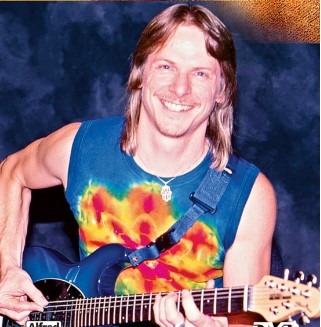Click here for text in English –>
Joskus 70-80-luvun vaihteessa olin oppinut lukemaan yhdysvaltalaista kitaralehteä Guitar Player kirjastossa. Suosikkieni kuten Eddie Van Halen lisäksi siellä esiteltiin yhdysvaltalaista kitaristia, joka oli tuunannut Fender Telecaster-kitarastaan mikrofoneja lisäämällä sellaisen version, jolla sai monen eri kitaramallin soundit eli äänimaailman. Kitaristin nimi on Steve Morse.
Koska Steve Morsen muusikkopersoonan ja uran vaiheista löytyy runsaasti aineistoa, näkökulmani tässä blogissa on omat kokemukseni. (Steve Morsen omat kotisivut: linkki ja Wikipedia: linkki). Esimerkiksi täydellistä diskografiaa hänen musiikillisista tuotoksistaan uskon olevan ehkä mahdoton tehdä, sen verran monessa eri yhteydessä herra on vaikuttanut.
Steve Morsen musisointi on varsin virtuoosimaista, teknistä, paljon kitarasooloja sisältäen. Se voi tavalliselle musiikin kuuntelijalle mennä vähän yli tai ohi. Itseäni, kitaransoiton harrastajana virtuoositeetti ei toki haittaa, päinvastoin. Se antaa mahdollisuuksia musiikillisen ilmaisun kokeiluihin. Yksi Steven soittotekniikan piirre on nuotti- ja sointuharmonioiden hallinta, eli että hän venyttää kieliä steel-kitaran tavoin, luoden kauniita sointuja, jotka kuulostavat viulu- tai jousisoitinorkesterilta. Mutta varsinkin Yhdysvaltain markkinoilla levy-yhtiöt kaipasivat artistilta ”radiohittiä”, ja tästä seikasta Steve Morsen ja hänen yhtyeidensä suurempi suosio kärsi mitä ilmeisimmin. Jopa niin, että hän siirtyi matkustajakoneen lentäjän uralle hetkeksi aikaa, vuosina 1987-1988. Hän toki lentää yhä.
Kaikki blogissa esiintyvät kuvat ovat omista kokoelmistani. Poislukien Steve Morse-kitaramallit.
Dixie Dregs
Steve esiintyi ja levytti 1970-luvun puolivälistä Dixie Dregs-nimisen (linkki) bändinsä kanssa Yhdysvalloissa. En ole päässyt selville, onko Dixie Dregs vai The Dixie Dregs oikea bändin kirjoitusasu. Molempia näkyy käytettävän. Noihin aikoihin Suomen radiokanavilla ei tuollainen musiikki soinut, kun Uusi aalto ja Punk olivat nosteessa. En osannut Steveä enempää noteerata, kun musiikin ääreen ei päässyt. No, kai se osoittaa jotain, että uusi aalto ja punk ovat suurimmalta osin vaipuneet unholaan, kun taas Steve Morsen musiikki on kenties ikuista, ajatonta.
80-luvulle tultaessa Steve Morse oli voittanut useita Guitar Player-lehden ”Best Overall Guitarist”-äänestyksiä. Kitaransoittoa minun lailla harrastava ystäväni hankki v. 1984 Steve Morsen soololevyn ”The Introduction” (linkki) ja toi sen minun levylautaselleni soimaan. Olin myyty samantien. Steve Morsen soitto on virtuoosimaista pitkine soolojuoksutuksineen ja hänellä on aina ollut oma tunnistettava soundi- ja sävelmaailmansa. Hän hallitsee useita eri tyylejä rockista klassiseen. Musiikki on valtaosin instrumentaalista, mutta useilla hänen oman bändinsä levyillä on laulettujakin kappaleita, todennäköisesti levy-yhtiön vaatiessa paremmin myyvää radiohittiä. Itse en ole valtavirran hittejä osannut kaivata, hänen kitara- ja säveltaituroinnista nauttiessani.
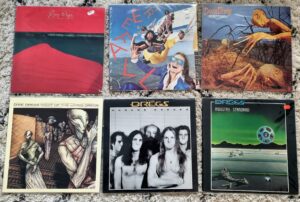
Ensimmäinen levytyksistä, The Great Spectacular (kuva 3, ylinnä) on varsinainen keräilyharvinaisuus. Sain senkin kuitenkin hankittua Yhdysvalloista Ebay’n kautta.
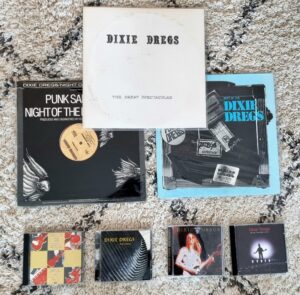
Dixie Dregsin tuotannossa ei musiikillisesti heikkoa lenkkiä juuri ole. Esimerkiksi country-tyylistä voisi poimia The Bash-hurjastelun. Take It Off the Top-on rocktyylinen instrumentaali, josta tehtiin myös singlelevytys, käyden listojen kärjessäkin hetkisen. Samantyyppinen on kappale Cruise Control.
Mainittakoon, että kuvassa 3 näkyvän Dregsin kokoelma-CD:n Divided We Stand paperivihon sisäkanteen sain Steve Morsen nimikirjoituksen (kuva 13). 90-luvulle tultaessa olen hankkinut myös kaikki Dixie Dregsin, sittemmin Dregsin albumilevytykset (kuvat 2 ja 3) Löysin niitä erityisesti levydivareista USA:n työreissujen yhteydessä.
Steve Morse Band, Kansas
The Introduction-levyn jälkeen seuraavat huomaamani levytykset 80-luvulla olivat Steve Morse Band-kokoonpanolla, jotka olen kaikki hankkinut (kuva alla).

Steve Morse Band-tuotanto on sinänsä jo valtavaa. Jos nyt esimerkin sieltä poimisi, niin kaunis instrumentaalikappale Long Lost albumilta Coast to Coast on ollut kestosuosikkini. Albumikokonaisuutena Southern Steel on mielestäni paras. Sitä ei löydy Spotifystä.
Steve oli yhdysvaltalaisen Kansas-yhtyeen (linkki) kitaristina vuosina 1986 – 1988. Alla olevassa kuvassa näkyy hallussani olevaa tuotantoa siltä yhtyeeltä. Kansasin suosituin hitti ehdottomasti on Carry On Wayward Son (linkki), jota kuulee radiosoitossa vieläkin. Levytyksen aikaan (1977) tosin Steve ei ollut yhtyeessä.

Kansasin Power-kappale samannimiseltä levyltä on hyvin radiohitti-henkinen teos. Kappaleessa Taking In The Wiew Steven kaunis kitarointi pääsee oikeuksiinsa, yhdistettynä laulusolisti Steve Walshin tenoriin. Levyltä In The Spirit of Things-levyltä singleksi poimittiin Stand Beside Me, niinkuin kuvassa 5 näkyy. Itse pidän paljon The Preacher-kappaleesta. Rainmaker on hieman teatraalis-musikaalinen teos. Sateentekijän tarina juontanee juurensa Yhdysvaltain Keski-Lännen maatalouskulttuurista, jonka ajoittain ankarista sääolosuhteista on tehty monia lauluja. Kappale House On Fire sisältää hienon Morsen kitarariffin ja T.O. Witcher kaunista akustista kitarointia.
Angelfire, Living Loud, Flying Colors
Steve on esiintynyt muissakin rockyhtyeissä tai ainakin heidän levyillään, kuten Living Loud (linkki) sekä Flying Colors (linkki). Esimerkiksi Steve Morsen suomenkielinen Wikipedia-sivu jättää huomiotta Angelfire-kokoonpanolla (linkki) tehdyn levytyksen (v. 2010), jonka omistan (kuva 4 alinna). Yhtye koostui Steven lisäksi laulaja Sarah Spenceristä. Musiikki osoittaa Steven taidot klassisen, sanoisinko barokkityylisen musiikin soitannassa ja säveltämisessä.
Living Loud-yhtyeessä soitti Uriah Heep-yhtyeen rumpali Lee Kerslake, kosketinsoittaja Don Airey (jonka kanssa Steve soitti myöhemmin Deep Purplessa), basisti Bob Daisley sekä laulusolisti Jimmy Barnes. Bändi levytti mm. Black Sabbath-laulajalegenda Ozzy Osbournen kappaleet I Don’t know, Crazy Train, Flying High Again ja Mr. Crowley. Syynä tähän olivat herrojen Daisley&Kerslake ja Osbourne riidat kappaleiden rojalteista. Studioalbumi jäi bändin ainoaksi, sen lisäksi on muutama livetaltiointi. Musiikki on kitara-hardrock-tyylistä, verraten muuhun Morsen tuotantoon suoraviivaisempaa kuin Deep Purple.
Flying Colors-yhtyeen tyylilaji on progressiivinen rock, joka voisi paikoitellen olla lähellä Dixie Dregs-yhtyeen viimeisimpiä levyjä, jotka sisälsivät laulettuja kappaleita. Steven kitaroinnin lisäksi laulua hoiti Casey McPherson, koskettimissa ja laulussa Neil Morse, rummuissa Mike Portnoy (ex-Dream Theater) ja bassossa Dave LaRue (jonka kanssa Steve on tehnyt yhteistyötä laajasti). Muista Steven yhtyeestä poiketen, bändi tarjoaa moniäänistä laulua.Flying Colors-yhteen aikana hankin tallenteita mp3-formaatissa, laillisesti niistä maksamalla. Omistamiani tallenteet näkyvät seuraavassa kuvassa. Flying Colors-yhtyeeltä on ilmestynyt myös mm. levytykset Live in Europe (2013), Second Nature (2014), Third Degree (2019), jotka olen kuunnellut Spotify-suoratoistopalvelusta.
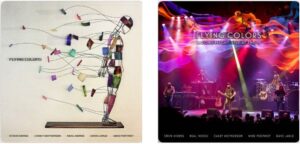
Kuvan Second Flight Live-levyltä erityisesti pidan kappaleesta Peaceful Harbor, jonka kauneudessa on jotain yhtäläisyyttä Steven omien huippubiisien kanssa. Steven kitaran rakennellessa harmonisia kuvioita ja juoksutuksia melodian kanssa yhdessä.
Steve Morsen muu tuotanto
Steve on levyttänyt myös pelkästään omalla nimellään, käyttäen vierailevia muusikoita muissa soittimissa. Seuraavassa kuvassa tätä tuotantoa.
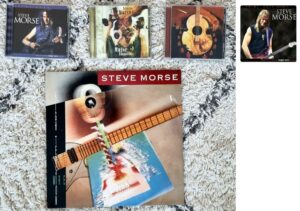
Prime Cuts-levyille Steve Morse on tallentanut omia sävellyksiään, jotka ovat saaneet vaikutteita toisilta kitaristeilta ja muusikoilta. Prime Cuts 2-levyn Portrait lähentelee jo jazz-musiikkia. Major Impacts-levyillä hän esittää omia sävellyksiään, jotka myös myötäilevät omien musiikillisten vaikutteidensa tyyliä, kuten Eric Clapton, Jimi Hendrix, Jeff Beck, The Byrds, Jimmy Page (Led Zeppelin-kitaristi), The Rolling Stones, Mountain ja Kansas.
High Tension Wires-levyltä voisin mainita skotlantilais-kansanmusiikkityylisen kappaleen Highland Wedding. Olen itsekin harjoitellut sitä kitaralla soittamaan. Kuvassa 7 esiintyvien albumien lisäksi on ilmestynyt ainakin The Sessions vuonna 2016.
Soitosta puheenollen, Steve Morse on tehnyt myös sähkökitaran sekä akustisen kitaran soiton opetusvideoita. Olen hankkinut niitä sekä VHS- että DVD-formaatissa. Steve teki klassisen kitaran soitosta myös C-kasetteja (kuva 8). Joita en tiedä julkaistun uudestaan muussa muodossa, ollen täten melkoisia harvinaisuuksia. Kasetit hankin yhdysvaltalaisen työkollegani avustuksella.
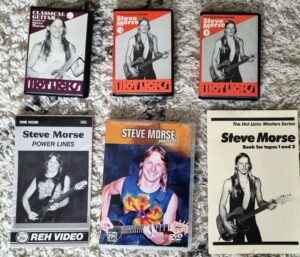
Seuraavassa kuvassa on omistamiani konserttitaltiointeja DVD-formaatissa. Video-konserttitaltiointeja on lukuisia muitakin, varsinkin Deep Purplen ajalta.
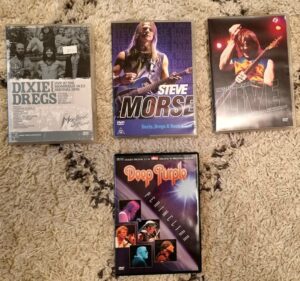
Steve Morse Deep Purple’n kitaristina
Keski-ikäinen ja varttuneempi yleisö tuntenee Steven parhaiten brittiläisen Deep Purple-yhtyeen (linkki) kitaristina. Deep Purplen kitaristilegenda Ritchie Blackmore (linkki) jätti yhtyeen ja Morse liittyi v. 1994. Blackmore on aina ollut myös suosikkini, todellinen rock- ja hardrock-musiikin elävä legenda. Kuulemma bändin miettiessä Ritchien korvaajaa, useamman jäsenen heistä suosikkilistoilla oli Steve Morse.
Ensimmäinen Deep Purple-levytys Steve Morsen kanssa oli Purpendicular (1996). Esimerkiksi bändin keikkaohjelmistoon pysyvästi jääneessä kappaleessa Sometimes I Feel Like Screaming Morsen kitaroinnin jäljet on selvästi tunnistettavissa. Sen jälkeen ovat ilmestyneet Abandon (1998), Bananas (2003), Rapture of the Deep (2005), Now What?! (2013), Infinite (2017), Whoosh! (2020) ja Turning to Crime (2021). Kolmea viimemainittua en ole hankkinut, vaan tarkistanut ne Spotify-suoratoistopalvelusta. Ne toistavat aika lailla edellisten viiden studiolevyn kaavaa. Esimerkiksi Turning to Crime on pelkkiä toisten bändien ja artistien cover-kappaleita.
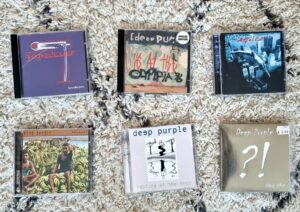
Steve jäi Deep Purplesta pois vuonna 2022 johtuen vaimonsa vakavasta sairastumisesta. Perustellen, että hän ei voi tehdä kiertueita Yhdysvaltain ulkopuolella, koska haluaa pysyä vaimonsa tukena. Hän on käsittääkseni kuitenkin esiintynyt omilla kokoonpanoillaan. Steve on tällä hetkellä 68-vuotias.
Steve on tehnyt keikkoja ja uutta musiikkia Steve Morse Band ja Dixie Dregs-yhtyeiden kanssa myös Deep Purple- kiertueiden ja levytysten välissä. Samoin erilaisissa kitaristien keskinäisissä jamittelukokoonpanoissa mm. kitaristien Steve Vai ja Joe Satriani kanssa G3-kiertueella. Harmittavasti nämä kiertueet ovat olleet lähinnä Yhdysvalloissa.
Steven muissa kuin esiin tuomissani yhteyksissä tekemänsä esiintymiset ja musiikkitaltioinnit on listattu Steve Morsen englanninkielisellä Wikipedia-sivulla (linkki). Tuskin tuokaan lista läheskään täydellinen on.
Steve Morsen kitarat
Steve Morsen kitarointi on edellyttänyt myös persoonallista soitinta. Koko 1980-luvun Morse käytti mukautettua Frankentele-kitaraa (linkki), joka koostui Fender Telecaster-kitaran rungosta, jossa oli Fender Stratocaster-kitaran kaula. Siinä oli myös Gibson-kitaran trapetsityylinen takakappale (joka on peräisin 12-kielisestä kitarasta). Tuunattu kitara on seuraavassa kuvassa 11. Kuvassa näkyy, että lähellä tallaa ja otelautaa Steve on asentanut ns. tuplakelaiset Humbucker-tyylin mikrofonit. Keskemmällä on 2 yksikelaista mikrofonia, joista voi saada Telecasterin alkuperäisen soittosoundin. Näillä, ja niiden keskinäisillä yhdistelmillä Steve totesi saavansa kaikkien erityyppisten sähkökitaroiden soundin. Kerran kitarassa oli viides mikrofoni, heksafoninen mikrofoni, jossa oli erillinen lähtö jokaiselle kielelle; se antoi signaalin 360 Systems Spectre -kitarasyntetisaattorin ohjaamiseen.

Morse työskenteli Music Man Guitars’in (nykyään Ernie Ball Music Man) kanssa luodakseen kaksi tunnusomaista mallia: modernisoitu versio Morsen ensimmäisestä Frankenstein Telecaster -kitarasta (Steve Morse Signature) ja Steve Morse SM Y-2D, on päivitetty versio, jossa on tikattu vaahterakansi. Mikrofonit on tässä versiossa vähän erilaiset kuin aiemmissa. Music Man-kitaroilla Steve on soitellut suurimman osan urastaan, mm. Deep Purplessa.
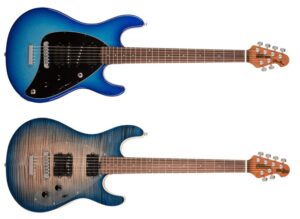
Omat kokemukset Steve Morsesta
Kesäkuussa 1990 huomasin sanomalehti Aamulehdestä, että Ikaalisissa pidettiin kitaristeille tarkoitettu soittoleiri, jossa mukaan opettajiksi oli saatu kitaristit Steve Morse ja Frank Gambale. Frank on myös huomioitu yhdysvaltalaisissa kitaralehdissä ja omistan myös joitain hänen levyjään. Leiriltä osallistuttiin konserttiin Midnight Sun Festival. Sinne oli pakko päästä. Kun pääsin perille, sain nimikirjoitukset sekä Steveltä että Frankiltä. Konsertissa bändin kokoonpanossa Steven ja Frankin lisäksi oli mm. basisti Pekka Pohjola, myös oma suosikkini. Otin useita valokuvia ko. tilaisuudesta ja sain Steven omistuskirjoituksen yhteen niistä (kuva 13), kun lähetin ns. fanikirjeen hänelle, johon hän vastasi. Keikalla sain nimmarin CD-levyn paperivihkon sisäkanteen, joka on myös kuvassa. Mainittakoon, että kuvassa 13, musiikkifestivaalin yhteydessä mainostetuissa ”riehakkaissa olutfestareissa” en vieraillut, ollen tällöin pienten lasten isä, perheellinen mies.

Toinen kohtaaminen tapahtui Pittsburghissa työmatkani yhteydessä kesäkuussa 1994. Dixie Dregs’iltä oli juuri ilmestynyt studiolevy Full Circle. Huomasin paikallisessa levykaupassa, kun ostin levyn, että Dixie Dregs-yhtye esiintyi eräällä musiikkiklubilla (Graffiti). Pienen epäröinnin jälkeen hyppäsin taksiin ja menin paikalle. Konsertti oli hieno ja sain kaikilta bändin jäseniltä nimikirjoitukset. Mukana soittamassa oli myös basisti Dave LaRue, jonka kanssa Steve on soittanut pitkään, samoin rumpali Rod Morgenstein, joka on soittanut myös yhdysvaltalaisessa Winger-yhtyeessä. Jos en tuolle hienolle keikalle olisi mennyt uskalluksen puutteen takia, olisin ehkä katunut vielä tänäkin päivänä. Yhdysvaltain isoissa kaupungeissa liikkuessa on toki aina syytä olla varuillaan.

Deep Purplen keikoilla Steve Morsen kaudella olen käynyt kerran Jyväskylässä 2006 sekä Helsingissä kaksi kertaa (Helsingin jäähalli ja Hartwall-Areena). Jälkimmäisessä Deep Purple esiintyi sinfoniaorkesterin kera – tosin bändin soittaessa rock-tyyliin niin kovaa, ettei sinfoniaorkesterin ääntä juuri erottanut. Konserteissa huomaa selvästi, että bändi on painottanut 70-luvulla tehtyihin klassikoihinsa, soittaen jokusen kappaleen kulloinkin uusimmalta levyltään. On luonnollista, että yleisö haluaa kuulla tietyt rockin klassikot yhä uudestaan, suurimpana niistä ehkä Smoke on the Water. Johon Steve lisää omat persoonalliset kitaroinnin mausteensa.
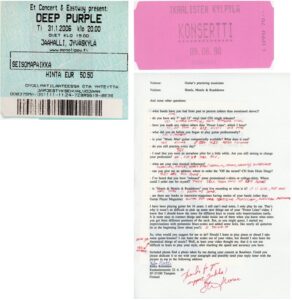
Viiden oman konserttikokemuksen jälkeen ei ole ollut enää tarvetta uusia Deep Purple-keikkavierailua. Yksi viimeisimpiä Deep Purplen keikkoja Suomessa on ollut Tampereen Hakametsän jäähallin kentällä, heinäkuussa 2022 (linkki). Siinä tosin Steve Morsen poisjäännin takia kitarassa oli Simon McBride. Samalla keikalla esiintyi myös hard rock-legenda Uriah Heep sekä suomalainen Andy McCoy (ent. Hanoi Rocks).
Mutta se MUSIIKKI!
Kuten jutusta näkee, Steve Morsella on mittava, lähemmäs 50 vuotta kestänyt ura ja valtava musiikkituotanto. Suoratoisto Spotifyn laskureiden perusteella Steve Morsen kappalekuuntelut liikkuvat kymmenissä ja sadoissa tuhansissa, kun taas esimerkiksi Deep Purplen suosituimmat kymmenissä ja sadoissa miljoonissa. Samoin kuin monet populäärimusiikin yhden hitin tähdenlennotkin helposti ovat miljoonien luokassa. Steven musiikki ei siis yllä miljoonamenestyksiin, mutta fanikunta on varmasti uskollista läpi vuosikymmenten.
Musiikkitallenteiden keräyksessä muutoksen kohdallani aiheutti digin ja suoratoiston, erityisesti Spotifyn, esiinmarssi. Ja ehkä myös siihen liittyvä mukavuudenhalu – sekä se ikävä fakta, että Steve Morsen esiintymistallenteita on ehkä vaikea kerätä täydellisesti. Ainakaan Suomesta käsin. Steve Morsen tuotannon alkupää minulla on varsin kattavasti fyysisinä tallenteina, lähinnä LP- ja CD-levytyksinä. Singlejä ja EP-levyjä on jokunen. Musiikki ratkaisee, ei se, että sama levytys on eri muovinpaloilla. Toisaalta läheskään kaikkea musiikkia ei ole saatavissa Spotifystä.
Steve Morsen tallennetuotanon ehkä varmin tarkistuspaikka on discogs.com (linkki). Sen huomaan olevan kaikkien fyysisten äänitallenteiden, erityisesti vinyylien keräilijöiden referenssi.
Steve Morsen kitarointiin painottava musiikki on itselleni monesti todella rentouttavaa ja nautinnollista. Sanalla sanoen täydellistä. Jos jokusen kritiikin sanan voisi sanoa, niin mittava kuin hänen uransa Deep Purplessa on ollutkin, koukeroinen ja juoksutuksia sisältävä soolotyyli ei minusta ole suoraan hard rockiin paras – esim. Simon McBriden suoraviivainen tyyli sopii paremmin. Steve on kitaroineen omiaan oman täydellisen musiikkinsa pariin.
Guitarist Steve Morse, my music collection
Sometime at the turn of the 70s and 80s, I had learned to read the American guitar magazine Guitar Player in the library. In addition to my favorites such as Eddie Van Halen, there was also an American guitarist who had rearranged the microphones from his Fender Telecaster guitar by developing a system that produced the sounds of many different guitar models. The guitarist’s name is Steve Morse.
Since there is a lot of material about the phases of Steve Morse’s musician personality and career, my perspective in this blog is my own experiences. (Steve Morse’s own homepage: link and Wikipedia: link). For example, I think it might be impossible to make a complete discography of his musical productions, the gentleman has been influential in so many different contexts.
Steve Morse’s musicianship is quite virtuosic, technical, including a lot of guitar solos. For the average music listener, it can be a bit ”over and out”. As a guitar player myself, virtuosity certainly doesn’t bother me, on the contrary. It gives opportunities for experiments in musical expression. One feature of Steve’s playing technique is his mastery of note and chord harmonies, meaning that he bends the strings like a steel guitar, creating beautiful chords that sound like a violin or string orchestra. But especially in the US market, the record companies wanted a ”radio hit” from the artist, and the greater popularity of Steve Morse and his bands most obviously suffered from this fact. Even so that he switched to the career of an airline pilot for a while, in 1987-1988. He is still flying.
All Figures appearing in the blog are from my own collections. Except those about his guitars.
Dixie Dregs
Steve performed and recorded from the mid-1970s with his band called Dixie Dregs (link) in the USA. I haven’t been able to find out if Dixie Dregs or The Dixie Dregs is the correct spelling of the band. Both appear to be used. In those days, Finnish radio channels didn’t play that kind of music, when New Wave and Punk were on the rise. I couldn’t quote Steve anymore when I couldn’t reach the music. Well, I guess it shows something that new wave and punk have largely faded into oblivion, while Steve Morse’s music is perhaps eternal, timeless.
Entering the 80s, Steve Morse had won several Guitar Player magazine Best Overall Guitarist polls. In 1984, a friend of mine who likes to play guitar bought Steve Morse’s solo record The Introduction (link) and brought it to my turntable to play. I was sold immediately. Steve Morse’s playing is virtuosic with long solo runs and he has always had his own recognizable world of sound and tone. He masters several different styles from rock to classical. The music is mostly instrumental, but several of his band’s records have singers and singing, probably because the record company demanded a better-selling radio hit. I myself haven’t been able to dig mainstream hits, while enjoying his guitar and composition skills.

Figure 2. Steve Morse’s recordings with the Dixie Dregs band. From top left:) ”What if” (1978), ”Free fall” (1977), ”Dregs of the Eearth” (1980). Bottom row from left: “Night of the Living Dregs” (1979), “Unsung Heroes” (1981) and “Industry Standard” (1982).
The first of the recordings, The Great Spectacular (Figure 3, top) is a true collector’s rarity. However, I was able to get it from the United States via Ebay.

Figure 3. Steve Morse’s first LP recording “The Great Spectacular” (1976). The middle row also shows the Dixie Dregs’ EP ”Punk Sandwich” and the compilation LP ”Best of the Dixie Dregs” (1987). The CDs in the bottom row are the Divided we Stand collection (1989), the Full Circle studio album (1994) and the live albums Dixie Dregs King Biscuit Flower Hour (1997) and Bring’Em Back Alive (1992).
In the production of Dixie Dregs, there is hardly any musical weakness, showing Steve Morse’s control over different musical styles. For example, from the country style, you could pick up The Bash, as example of speed picking. Take It Off the Top-is a rock-style instrumental, which was also made into a single recording, hitting the top of the charts for a while. The song Cruise Control is similar.
I should mention that I got Steve Morse’s autograph on the inner cover of the Dregs compilation CD ”Divided We Stand” shown in Figure 3 (autograph Figure 13). In the 90’s, I also acquired all Dixie Dregs, later Dregs album recordings (Figures 2 and 3). I found them especially on second-hand shops during business trips to the USA.
Steve Morse Band, Kansas
After The Introduction, the next recordings I noticed in the 80’s were with the Steve Morse Band, all of which I have acquired (Figure below).

Figure 4. Steve Morse Band recordings. The Introduction (1984, vinyl), Stand Up (1985, vinyl), Southern Steel (1991, vinyl), Coast to Coast (1992, CD), Structural Damage (1995, CD), Stressfest (1996, CD), Split Decision (2002, CD), Out Standing in Their Field (2009, CD). The bottom row contains the Angelfire line-up CD (2010).
The Steve Morse Band production is already huge in itself. If I were to pick an example from there, the beautiful instrumental song Long Lost from the album Coast to Coast has been my all-time favorite. As an entire album, I think Southern Steel is the best. It cannot be found from Spotify.
Steve was the guitarist of the American band Kansas (link) from 1986 to 1988. In the Figure below the picture shows the production I have from that band. Kansas’ most popular hit is definitely Carry On Wayward Son (link), which is still played on the radio. At the time of recording (1977), however, Steve was not in the band.

Figure 5. On the top left, the Kansas band’s album In the Spirit of Things (1988), next to it the EP release ”Stand Beside Me” from the same album. The one on the right is the Kansas LP Power (1986). In the bottom row, on the left, Lynyrd Skynyrd’s live LP ”Tribute Tour 1997” and the CD’s Kansas Dust In the Wind Live (1997) and below it Living Loud (2005) from the band of the same name.
Kansas’s song Power from the album of the same name is a very radio hit-type piece. In the song Taking In The View, Steve’s beautiful guitar playing comes into its own, combined with the tenor of vocal soloist Steve Walsh. Stand Beside Me was taken as a single from the album In The Spirit of Things, as shown in Figure 5. Personally, I like The Preacher a lot. Rainmaker is a somewhat theatrical-musical work. The story of the rainmaker must have its roots in the agricultural culture of the American Midwest, which has been the subject of many songs about the sometimes harsh weather conditions. The song House On Fire contains a great guitar riff by Steve and T.O. Witcher beautiful acoustic guitar playing.
Angelfire, Living Loud, Flying Colors
Steve has also appeared in other rock groups or at least on their records, such as Living Loud (link) and Flying Colors (link). For example, Steve Morse’s Finnish Wikipedia page ignores the recording (2010) made with the Angelfire configuration (link), which I own (Figure 4 bottom). In addition to Steve, the band consisted of singer Sarah Spencer. The music shows Steve’s skills in playing and composing classical, I would say baroque style music.
The Living Loud band consisted of Uriah Heep drummer Lee Kerslake, keyboardist Don Airey (with whom Steve later played in Deep Purple), bassist Bob Daisley and vocalist Jimmy Barnes. The band recorded e.g. Black Sabbath singer legend Ozzy Osbourne’s songs I Don’t know, Crazy Train, Flying High Again and Mr. Crowley. The reason for this was misters Daisley&Kerslake and Osbourne’s disputes over song royalties. The studio album was the band’s only one, besides that there are a few live recordings. The music is in a guitar-hard rock style, compared to the rest of Morse’s production, it is more straightforward than Deep Purple.
The style of the Flying Colors band is progressive rock, which in some places can be close to the Dixie Dregs’ last records, which contained sung songs. In addition to Steve’s guitar, vocals were handled by Casey McPherson, keyboards and vocals by Neil Morse, drums by Mike Portnoy (ex-Dream Theater) and bass by Dave LaRue (with whom Steve has collaborated extensively). Remember, unlike Steve’s band, the band offers polyphonic vocals. During the Flying Colors band, I obtained recordings in mp3 format, legally paying for them. The recordings I own are shown in the following image. The band Flying Colors has also released e.g. recordings Live in Europe (2013), Second Nature (2014), Third Degree (2019), which I have listened to on the Spotify streaming service.

Figure 6. My recordings of the band Flying Colors (in mp3 format). Flying Colors (2012) and the live recording Second Flight Live at the ZZ (2015).
I especially like the song Peaceful Harbor from the album Second Flight Live, the beauty of which has something in common with Steve’s own top songs. When Steve’s guitar builds harmonic patterns and flows together with the melody.
Steve Morse’s other output
Steve has also recorded under his own name alone, using guest musicians on other instruments. The next Figure shows this production.

Figure 7. Steve Morse’s recordings under his own name. Top right from left Prime Cuts (2005), Major Impacts (2000), Major Impacts 2 (2004) and Prime Cuts 2 (2009). Bottom Line High Tension Wires (1989).
On the Prime Cuts records, Steve Morse has recorded his own compositions, which have been influenced by other guitarists and musicians. Portrait from the Prime Cuts 2 album already approaches jazz music. On the Major Impacts records, he performs his own compositions, which also follow the style of his own musical influences, such as Eric Clapton, Jimi Hendrix, Jeff Beck, The Byrds, Jimmy Page (Led Zeppelin guitarist), The Rolling Stones, Mountain and Kansas.
From the album High Tension Wires, I could mention the Scottish folk music style song Highland Wedding. I myself have practiced playing it on the guitar. In addition to albums of Figure 7, The Sessions has been released in 2016.
Speaking of playing, Steve Morse has also made instructional videos for playing the electric guitar and the acoustic guitar. I have acquired them in both VHS and DVD format. Steve also made C-cassettes from classical guitar playing (Figure 8). Which I don’t know have been republished in another format, so they are quite rare. I got the cassettes with the help of my American work colleague.
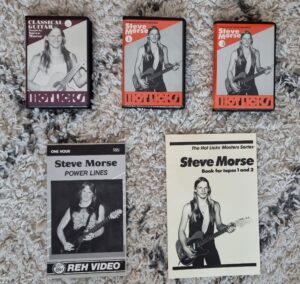
Figure 8. Steve Morse’s guitar educational recordings as C-cassette (Hot Licks 1 and 2, Classical guitar), DVD video (Power Lines) and related sheet music.
The following picture shows the concert recordings I own in DVD format. There are numerous other video concert recordings, especially from Deep Purple’s time.

Figure 9. Concert recordings Dixie Dregs Live at the Montreaux Jazz Festival 1978, Sects, Drugs and Rock&Roll (2002), Steve Morse Band Live in the Baden (1990) and, at the bottom, Deep Purple Perhelion (2001).
Steve Morse as Deep Purple’s guitarist
The middle-aged and older audience knows Steve best as the guitarist of the British band Deep Purple (link).Deep Purple’s guitarist legend Ritchie Blackmore (link) left the band and Morse joined in 1994. Blackmore has always been my favorite, a real living legend of rock and hard rock music. It is said that when the band was thinking about Ritchie’s replacement, several members had Steve Morse on their favorite lists.
The first Deep Purple studio recording with Steve Morse was Purpendicular (1996). For example, in the song ”Sometimes I Feel Like Screaming”, which has permanently remained in the band’s concert repertoire, the traces of Morse’s guitar playing are clearly recognizable. Since then, Abandon (1998) has been released, Bananas (2003), Rapture of the Deep (2005), Now What?! (2013), Infinite (2017), Whoosh?! (2020) and Turning to Crime (2021). I haven’t purchased the last three, but checked them on the Spotify streaming service. They pretty much repeat the formula of the previous five studio albums. For example, Turning to Crime is just cover songs from bands and artists.

Figure 10. Steve Morse’s recordings as Deep Purple’s guitarist, CD format. Top row from left Purpendicular (1996), Live at Olympia’96, Abandon (1998) and bottom row Bananas (2003), Rapture of the Deep (2005), Now What?! (2013).
Steve left Deep Purple in 2022 due to his wife’s serious illness. Reasoning that he can’t tour outside of the US because he wants to stay supportive of his wife. However, as far as I can tell, he has performed with his own ensembles. Steve is currently 68 years old.
Steve has been doing gigs and new music with the Steve Morse Band and the Dixie Dregs, also between Deep Purple tours and recordings. Similarly, in various mutual jamming formations of guitarists, e.g. with guitarists Steve Vai and Joe Satriani on the G3 tour. Sadly, these tours have mostly been in the US.
Steve Morse’s performances and music recordings in contexts other than the ones I mentioned are listed on Steve Morse’s English Wikipedia page (link). That list is hardly complete.
Guitars by Steve Morse
Steve Morse’s guitar playing has also required a personal instrument. Throughout the 1980s, Morse used a custom ”Frankentele” guitar consisting of a Fender Telecaster body with a Fender Stratocaster neck. It also featured a Gibson guitar trapeze style tailpiece (derived from a 12-string guitar). The tuned guitar is in the following Figure 11. The Figure shows that near the bridge and fingerboard Steve has installed the so-called double humbucker style pickups. In the middle, there are 2 single-coil microphones, from which you can get the original playing sound of the Telecaster. With these, and their mutual combinations, Steve found that he could get the sound of all different types of electric guitars. At one time the guitar had a Fifth mic, a hexaphonic mic with a separate output for each string; it provided the signal to drive the 360 Systems Specter guitar synthesizer.

Figure 11. Steve Morse’s original, tuned Fender Telecaster guitar. Source: link.
Morse worked with Music Man Guitars (now Ernie Ball Music Man) to create two signature models: a modernized version of Morse’s first ”Frankenstein Telecaster” guitar (Steve Morse Signature) and the Steve Morse SM Y-2D, an updated version with a quilted maple top. In this later version, the microphone arrangements are slightly different. Steve has played with Music Man guitars for most of his career, e.g. In Deep Purple.
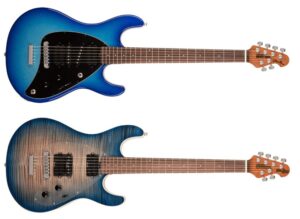
Figure 12. Music Man Steve Morse model guitar and below it a modified newer version Steve Morse Y2D. Source: Ernie Ball Music Man company website.
My own experiences with Steve Morse
In June 1990, I noticed in the newspaper Aamulehti that a playing camp for guitarists was being held in Ikaalinen with guitarists Steve Morse and Frank Gambale as teachers. Frank has also been featured in US guitar magazines and I also own some of his records. The camp participated in the concert ”Midnight Sun Festival”. I had to get there. When I got there I got autographs from both Steve and Frank. At the concert, in addition to Steve and Frank, the band’s composition included e.g. bass player Pekka Pohjola, also my favorite. I took several photos. about the occasion and I got Steve’s inscription on one of them (Figure 13) when I sent the so-called a fan letter to her that he responded to. At the gig, I got an autograph on the inner cover of the paper booklet of a CD, which is also in the picture. It should be mentioned that I did not visit the ”raucous beer festivals” advertised in connection with the music festival in picture 13, being a father of small children, a family man.

Figure 13. Top left, a photo taken by myself, Steve Morse in Ikaalinen in June 1990 at the Midnight Sun Festival concert. I got an autographed picture with my fan letter to him. On the right announcement of the festival in newspaper Aamulehti. At the bottom is the autograph I got on the inside of the CD, where Steve has drawn a logo-style picture of the guitar.
The second meeting happened in Pittsburgh during my work trip in June 1994. Dixie Dregs’ album Full Circle had just come out. I noticed at the local record store when I bought the record that the Dixie Dregs were performing at a music club (Graffiti). After a little hesitation, I jumped in a taxi and went to the place. The concert was great and I got autographs from all the band members. Also playing was bassist Dave LaRue, with whom Steve has played for a long time, as well as drummer Rod Morgenstein, who has also played in the American band Winger. If I hadn’t dared to go to that great gig p because of the hesitation, I might have regretted it even today. Of course, there is always a reason to be careful when moving around the big cities of the United States.

Figure 14. Above, the inner cover of the Dixie Dregs’ Full Circle album, with the autographs of each band member. From left: Steve Morse guitar, Dae LaRue bass, T. Lavitz keyboards, Rod Morgenstein drums and Jerry Goodman violin. In the lower picture, an article about Dixie Dregs’ Pittsburgh concert in the local record store’s magazine.
I’ve been to Deep Purple’s gigs in Steve Morse’s era once in Jyväskylä in 2006 and twice in Helsinki (Helsingin jäähalli and Hartwall-Areena). In the latter, Deep Purple performed with a symphony orchestra – although when the band played in a rock style, it was so loud that the sound of the symphony orchestra could hardly be distinguished. At the concerts, you can clearly see that the band has focused on their classics made in the 70’s, playing a song from their latest album at any given time. It’s natural that the public wants to hear certain rock classics over and over again, perhaps the biggest of them being Smoke on the Water. To which Steve adds his own personal guitar playing spices.

Picture 15. Concert tickets from Steve Morse’s Ikaalinen gig on June 9, 1990 and from Jyväskylä’s Hippos arena on January 31, 2006. At the bottom, a fan letter I received in 1990 with Steve Morse’s comments.
After five concert experiences of my own, there has been no need to visit Deep Purple again. One of Deep Purple’s latest gigs in Finland has been at the Hakametsä Ice Hall parking lot in Tampere, in July 2022 (link). However, due to Steve Morse’s absence, Simon McBride was on guitar. Hard rock legend Uriah Heep and Finn Andy McCoy (former Hanoi Rocks) also performed at the same gig.
But the MUSIC!
As you can see from the story, Steve Morse has a long, nearly 50-year career and a huge musical output. Based on Spotify’s music streaming service counters, Steve Morse’s tunes are listened to in the tens and hundreds of thousands, while, for example, Deep Purple’s most popular tunes are in the tens and hundreds of millions. Just like many shooting stars in popular music, one-hit stars are easily in the millions. So Steve’s music doesn’t reach million-dollar hits, but the fan base is certainly loyal throughout the decades.
When it comes to collecting music recordings, the change for me was caused by the rise of digital and streaming, especially Spotify. And maybe also the related desire for comfort – and the sad fact that it may be difficult to collect Steve Morse’s performance recordings completely. At least from Finland. I have the beginning of Steve Morse’s production quite comprehensively as physical recordings, mainly LP and CD recordings. There are some singles and EPs. It’s the music that counts, not the fact that the same recording is on different pieces of plastic. On the other hand, almost all music is not available on Spotify.
Perhaps the most reliable place to check Steve Morse’s record production is discogs.com (link). I find it to be the reference for all collectors of physical audio recordings, especially vinyl.
Steve Morse’s guitar-oriented music is often really relaxing and enjoyable for me. In a word, perfect. If I could say a word of criticism, as long as his career in Deep Purple has been, I don’t think the ”advanced” shred picking solo style is the best for hard rock – e.g. Simon McBride’s straightforward style is more suitable. With his guitars, Steve has created his own perfect music.

